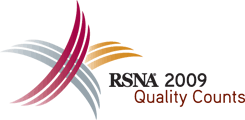
Abstract Archives of the RSNA, 2009
LL-IN2103-B02
Increasing Timeliness and Power of Registry Data: Report of a Pilot Radiation Oncology Registry System
Scientific Posters
Presented on November 29, 2009
Presented as part of LL-IN-B: Informatics
Shane Hopkins MD, Presenter: Nothing to Disclose
Liisa Oakes, Abstract Co-Author: Employee, Elekta AB
Sandhya Upasani, Abstract Co-Author: Employee, Elekta AB
Joel W. Goldwein MD, Abstract Co-Author: Vice President, Elekta AB
Automation and the use of historic data already captured within EMRs would allow for a registry with a widely distributed population and sufficient numbers for hypotheses requiring great statistical power.
Cancer data registries typically require some level of manual data entry and aggregation due to wide variance in charting methods and disparate selection of data captured. We created and tested a pilot registry consisting of real-time data derived through direct interface with electronic medical records (EMR) at 6 facilities to test the feasibility and quantify some of the benefits of a modality-wide implementation.
The vast majority of radiation oncology programs in North America utilize EMR systems that include collection of a core set of required data, including demographic, diagnostic, staging, treatment and follow-up information. We selected ~ 40 such discrete elements collected within the MOSAIQ™ EMR system (Impac Medical Systems), and used software to cull these data elements, de-identify them, and automatically upload them to a central registry. Between October 2008 and March 2009, 6 facilities enrolled in the program and successfully established monthly unattended data uploads of de-identified data. The aggregate data from these pilot sites includes a total of 121,124 patient records. There are ~2400 sites currently running compatible software (1500 sites running Impac software and 900 running Lantis). Assuming we had a representative sampling, if all were included in the registry, a total of 48,449,600 patient records would be available for analysis.
Results of this pilot suggest that the infrastructure can be developed into a robust data-sharing environment through which specialty-wide trends may be monitored. With increasing participation, iterative improvements in program logistics, quality control, and increasing data resolution, this registry could help address important clinical questions, provide objective evidence for advocacy efforts, support rapid assessment of emerging technologies, and improve the delivery of cancer care.
Hopkins, S,
Oakes, L,
Upasani, S,
Goldwein, J,
Increasing Timeliness and Power of Registry Data: Report of a Pilot Radiation Oncology Registry System. Radiological Society of North America 2009 Scientific Assembly and Annual Meeting, November 29 - December 4, 2009 ,Chicago IL.
http://archive.rsna.org/2009/8004028.html

